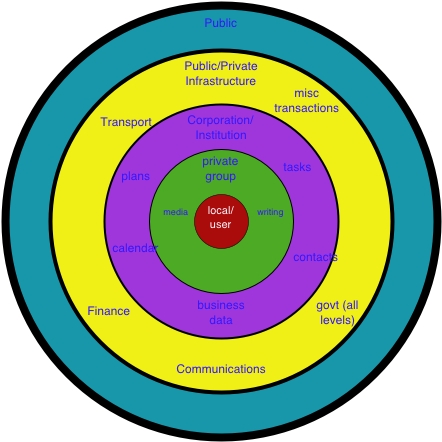W3C Semantic Web Update
Ralph R. Swick, W3C/MIT
DAML PI Meeting
16 October, 2003
slides in http://www.w3.org/2003/Talks/1016-SemWeb-rrs/
W3C's Goals for the Semantic Web
- extending the Web to be able to represent and reason over data on the
Web
- stimulate deployment of Semantic Web infrastructure throughout
commercial, government, and academic user communities
- insure coherent architecture for Semantic Web technology as part of the
larger World Wide Web
Current Activity Summary: WGs
Current Activity Summary: IG
- 1 Interest Group sponsoring 4 discussion lists
- www-rdf-interest
general developer & user forum
- www-rdf-calendar
specific focus on use of RDF for exchanging calendaring/scheduling
data
- www-rdf-logic
discussion of all approaches to the use of classical logic on the
Web for the representation of data such as inference rules,
ontologies, and complex schemata
325 subscribers
~60 messages/month in last 5 months
- www-rdf-rules
discussion of queries and rules for RDF data.
165 subscribers
~25 messages/month in last 5 months
Current Activity Summary: Coordination
- 2 Task Forces
- Liaison to Web Services Architecture WG and Web Services Choreography
WG
OWL Status
- DARPA + Academic + W3C combination has been extremely effective
- OWL Model Theory makes this one of the most carefully analyzed W3C
specifications -- a strong positive
- Candidate Recommendation is a very significant
milestone for the technical work
- Evidence that the specification is stable:
- Public has had the opportunity to review a final specification
- Working Group has responded to all comments from that review and
made no additional significant changes
- A CR specification is tested through practice; the
Community is asked to demonstrate that multiple interoperable
implementations of the specification can be built; WG is tallying CR implementation reports
for OWL
- OWL CR comments were requested by 20-September; comment period
continues due to dependency on RDF Core specifications
- OWL
Test Results tracking and reporting is an application of the Semantic
Web.
W3C Recommendation Track
- Working Draft(s)
- Last Call Working Draft
- Candidate Recommentation
- Proposed Recommendation
- Recommendation
Any of 1-3 can cycle back to 1 or 2 for technical changes.
(3) CR is a final technical review stage for the entire Community
- duration is proposed by the Working Group based on awareness of work in
progress and expected degree of implementation difficulty
(4) PR is a formal review stage in which the W3C Membership checks that
the WG has met its chartered objectives and that the result is a needed
enhancement to the Web
- duration is established by the Director
- critical to continue to educate the Community during the Proposed
Recommendation review
Note: An OWL Proposed Recommendation depends on reaching an RDF Core
Proposed Recommendation
Looking Forward
- Upcoming W3C Member meeting in November
- Expect to discuss a plan for:
- Increased emphasis on adoption and deployment of RDF and OWL
- Best Practices Working Group
- Rules Working Group
- Undecided about Query WG -- need to poll Members
- Web Services
- politically awkward, but
- recognition that the DAML-S approach to semantic descriptions of
services has long-term viability
- how to accomplish this in a way that is perceived as an enhancement
of current Web Services work?
Still Research/Advanced Prototype
How a Working Group is Created
Industry consensus-building (standardization) works most effectively
when it follows a research and multiple proof-of-concept development
phase.
Demands on Semantic Web Architecture
 |
Requirements
- Security
- High-granularity access control
- Privacy
- Intellectual Property management
W3C has faced these on the Web today:
- Platform for Privacy Preferences
- XML Signature, Encryption, Key Management
- DRD, in progress
|

